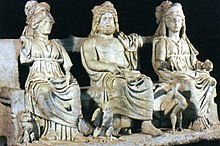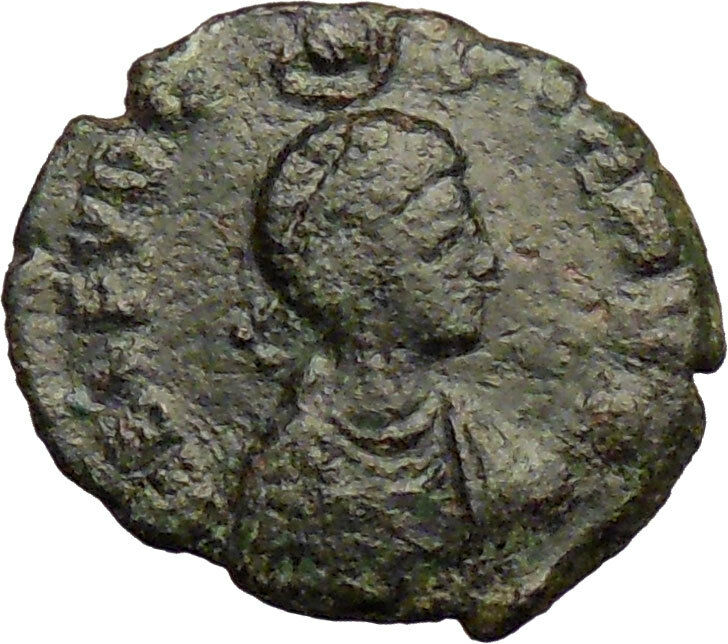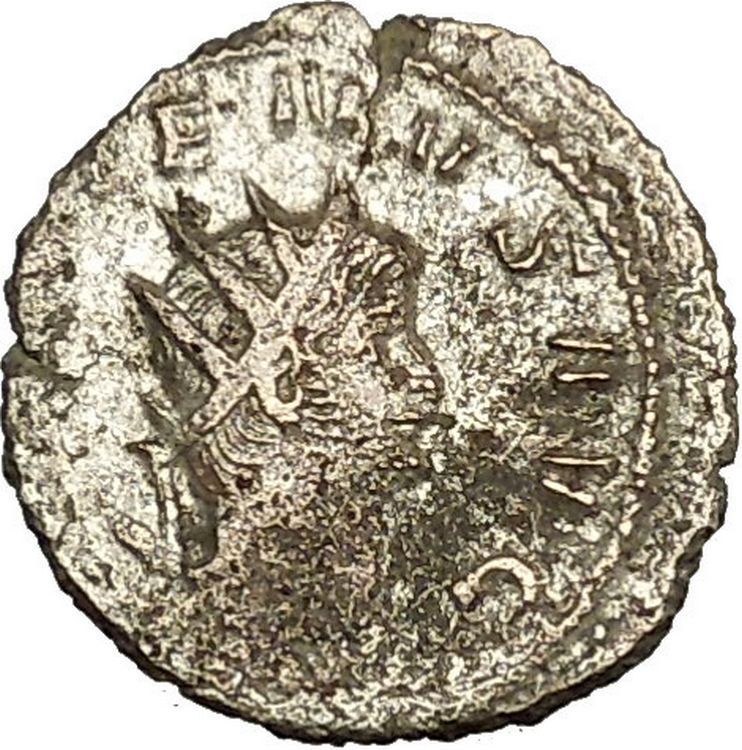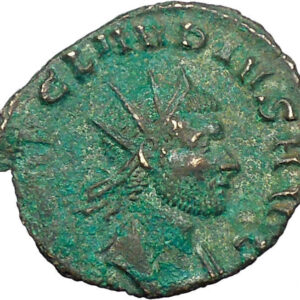|
Probus
–
Roman Emperor
: 276-282
A.D. –
Bronze Antoninianus 21mm (3.56 grams) Siscia mint: 276-282
A.D.
Reference: Bronze Antoninianus 23mm (4.05 grams) Siscia
mint: 281 A.D.
Reference: RIC 644a, C 87
IMPCMAVRPROBVSAVG – Radiate, draped bust right.
CLEMENTIATEMP Exe: V/XXI
– Probus standing right on left, holding scepter with
eagle atop,
receiving globe from Jupiter to right, holding scepter.
You
are bidding on the exact item pictured, provided with a
Certificate of Authenticity and Lifetime Guarantee of
Authenticity.

Royal/Imperial
symbols of power
Ruling dynasties often exploit pomp and ceremony with the use of
regalia
:
crowns
,
robes,
orb (globe) and sceptres
, some of which are reflections
of formerly practical objects. The use of language mechanisms also support this
differentiation with subjects talking of “the crown” and/or of “the
throne
” rather than referring directly to
personal names and items.
Monarchies
provide the most explicit
demonstration of tools to strengthen the elevation of leaders. Thrones sit high
on daises
leading to subjects lifting their gaze
(if they have permission) to contemplate the ruler. Architecture in general can
set leaders apart: note the symbolism inherent in the very name of the Chinese
imperial
Forbidden City
.
In
ancient Roman religion
and
myth
, Jupiter (Latin:
Iuppiter) or
Jove is the
king of the gods
and
the
god of sky
and
thunder
. Jupiter was
the chief deity of Roman state religion throughout the
Republican
and
Imperial
eras, until
the Empire
came under Christian rule
.
In
Roman mythology
, he
negotiates with
Numa Pompilius
, the
second
king of Rome
, to
establish principles of Roman religion such as
sacrifice.
Jupiter is usually thought to have originated as a
sky god. His identifying implement is the
thunderbolt
, and his
primary sacred animal is the eagle, which held
precedence over other birds in the taking of
auspices
and became one
of the most common symbols of the
Roman army
(see
Aquila
). The two
emblems were often combined to represent the god in the
form of an eagle holding in its claws a thunderbolt,
frequently seen on Greek and Roman coins. As the
sky-god, he was a divine witness to oaths, the sacred
trust on which justice and good government depend. Many
of his functions were focused on the
Capitoline
(“Capitol
Hill”), where the
citadel
was located. He
was the chief deity of the
early Capitoline Triad
with
Mars
and
Quirinus
. In the
later Capitoline Triad
,
he was the central guardian of the state with
Juno
and
Minerva
. His sacred
tree was the oak.
The Romans regarded Jupiter as the
equivalent
of Greek
Zeus
, and in
Latin literature
and
Roman art
, the myths
and iconography of Zeus are adapted under the name
Iuppiter. In the Greek-influenced tradition, Jupiter
was the brother of
Neptune
and
Pluto
. Each presided
over one of the three realms of the universe: sky, the
waters, and the underworld. The
Italic
Diespiter
was also a sky god who manifested himself in the
daylight, usually but not always identified with
Jupiter. The
Etruscan
counterpart
was
Tinia
and
Hindu
counterpart is
Indra
.
Relation to other gods
Archaic
Triad
The Archaic Triad is a theological structure (or
system) consisting of the gods Jupiter, Mars and
Quirinus. It was first described by Wissowa, and the
concept was developed further by Dumézil. The
three-function hypothesis of
Indo-European society
advanced by Dumézil holds that in prehistory, society
was divided into three classes (priests, warriors and
craftsmen) which had as their religious counterparts the
divine figures of the sovereign god, the warrior god and
the civil god. The sovereign function (embodied by
Jupiter) entailed omnipotence; thence, a domain extended
over every aspect of nature and life. The colour
relating to the sovereign function is white.
The three functions are interrelated with one
another, overlapping to some extent; the sovereign
function, although essentially religious in nature, is
involved in many ways in areas pertaining to the other
two. Therefore, Jupiter is the “magic player” in the
founding of the Roman state and the fields of war,
agricultural plenty, human fertility and welth.
Capitoline Triad

Capitoline Triad
The Capitoline Triad was introduced to Rome by the
Tarquins. Dumézil thinks it might have been an Etruscan
(or local) creation based on Vitruvius’ treatise on
architecture, in which the three deities are associated
as the most important. It is possible that the Etruscans
paid particular attention to
Menrva
(Minerva) as a
goddess of destiny, in addition to the royal couple Uni
(Juno) and Tinia (Jupiter).[169]
In Rome, Minerva later assumed a military aspect under
the influence of
Athena Pallas
(Polias).
Dumézil argues that with the advent of the Republic,
Jupiter became the only king of Rome, no longer merely
the first of the great gods.
Jupiter and Minerva
Apart from being protectress of the arts and craft as
Minerva Capta, who was brought from Falerii, Minerva’s
association to Jupiter and relevance to Roman state
religion is mainly linked to the
Palladium
, a wooden
statue of Athena that could move the eyes and wave the
spear. It was stored in the penus interior, inner
penus of the aedes Vestae, temple of Vesta and
considered the most important among the
pignora imperii
,
pawns of dominion, empire.[170]
In Roman traditional lore it was brought from Troy by
Aeneas. Scholars though think it was last taken to Rome
in the third or second century BC.
Juno
and Fortuna
The divine couple received from Greece its
matrimonial implications, thence bestowing on Juno the
role of tutelary goddess of marriage (Iuno Pronuba).
The couple itself though cannot be reduced to a Greek
apport. The association of Juno and Jupiter is of the
most ancient Latin theology.
Praeneste
offers a
glimpse into original Latin mythology: the local goddess
Fortuna
is represented
as milking two infants, one male and one female, namely
Jove (Jupiter) and Juno. It seems fairly safe to assume
that from the earliest times they were identified by
their own proper names and since they got them they were
never changed through the course of history: they were
called Jupiter and Juno. These gods were the most
ancient deities of every Latin town. Praeneste preserved
divine filiation and infancy as the sovereign god and
his paredra Juno have a mother who is the primordial
goddess Fortuna Primigenia.[174]
Many terracotta statuettes have been discovered which
represent a woman with a child: one of them represents
exactly the scene described by Cicero of a woman with
two children of different sex who touch her breast. Two
of the votive inscriptions to Fortuna associate her and
Jupiter: ” Fortunae Iovi puero…” and “Fortunae Iovis
puero…”
In 1882 though R. Mowat published an inscription in
which Fortuna is called daughter of Jupiter,
raising new questions and opening new perspectives in
the theology of Latin gods. Dumezil has elaborated an
interpretative theory according to which this aporia
would be an intrinsic, fundamental feature of
Indoeuropean deities of the primordial and sovereign
level, as it finds a parallel in Vedic religion. The
contradiction would put Fortuna both at the origin of
time and into its ensuing diachronic process: it is the
comparison offered by Vedic deity
Aditi
, the Not-Bound
or Enemy of Bondage, that shows that there is no
question of choosing one of the two apparent options: as
the mother of the
Aditya
she has the same
type of relationship with one of his sons,
Dakṣa
, the minor
sovereign. who represents the Creative Energy,
being at the same time his mother and daughter, as is
true for the whole group of sovereign gods to which she
belongs. Moreover Aditi is thus one of the heirs (along
with
Savitr
) of the opening
god of the Indoiranians, as she is represented with her
head on her two sides, with the two faces looking
opposite directions. The mother of the sovereign gods
has thence two solidal but distinct modalities of
duplicity, i.e. of having two foreheads and a double
position in the genealogy. Angelo Brelich has
interpreted this theology as the basic opposition
between the primordial absence of order (chaos) and the
organisation of the cosmos.
Janus
The relation of Jupiter to Janus is problematic.
Varro defines Jupiter as the god who has potestas
(power) over the forces by which anything happens in the
world. Janus, however, has the privilege of being
invoked first in rites, since in his power are the
beginnings of things (prima), the appearance of
Jupiter included.
Saturn
The
Latins
considered
Saturn the predecessor of Jupiter. Saturn reigned in
Latium
during a
mythical
Golden Age
reenacted
every year at the festival of
Saturnalia
. Saturn also
retained primacy in matters of agriculture and money.
Unlike the Greek tradition of
Cronus
and Zeus, the
usurpation of Saturn as king of the gods by Jupiter was
not viewed by the Latins as violent or hostile; Saturn
continued to be revered in his temple at the foot of the
Capitol Hill, which maintained the alternative name
Saturnius into the time of Varro.[182]
A. Pasqualini has argued that Saturn was related to
Iuppiter Latiaris, the old Jupiter of the Latins, as
the original figure of this Jupiter was superseded on
the Alban Mount, whereas it preserved its gruesome
character in the ceremony held at the sanctuary of the
Latiar Hill in Rome which involved a human sacrifice and
the aspersion of the statue of the god with the blood of
the victim.
Fides
The abstract
personification
Fides
(“Faith, Trust”) was one of the oldest gods associated
with Jupiter. As guarantor of public faith, Fides had
her temple on the Capitol (near that of Capitoline
Jupiter).
Genius
Augustine quotes Varro who explains the genius
as “the god who is in charge and has the power to
generate everything” and “the rational spirit of all
(therefore, everyone has their own)”. Augustine
concludes that Jupiter should be considered the
genius of the universe.
G. Wissowa advanced the hypothesis that Semo
Sancus
is the genius of
Jupiter.[189]
W. W. Fowler has cautioned that this interpretation
looks to be an anachronism and it would only be
acceptable to say that Sancus is a Genius Iovius,
as it appears from the Iguvine Tables.
Censorinus cites
Granius Flaccus
as
saying that “the Genius was the same entity as the Lar”
in his lost work De Indigitamentis. Dumézil
opines that the attribution of a Genius to the gods
should be earlier than its first attestation of 58 BC,
in an inscription which mentions the Iovis Genius.
A connection between Genius and Jupiter would be
apparent in
Plautus
‘ comedy
Amphitryon
, in
which Jupiter takes up the looks of
Alcmena
‘s husband in
order to seduce her: J. Hubeaux sees there a reflection
of the story that
Scipio Africanus
‘
mother conceived him with a snake that was in fact
Jupiter transformed. Scipio himself claimed that only he
would rise to the mansion of the gods through the widest
gate.
It is noteworthy that among the Etruscan Penates
there is a Genius Iovialis who comes after
Fortuna and Ceres and before Pales . Genius Iovialis is
one of the earthly Penates and not one of the Penates
of Jupiter though, as these were located in region I of
Martianus Capella’ s division of Heaven, while Genius
appear in regions V and VI along with Ceres, Favor
(possibly a Roman approximation to an Etruscan male
manifestation of Fortuna) and Pales.
Victoria

Coin with
laureate
head of Jupiter (obverse)
and (reverse) Victory, standing (“ROMA”
below in
relief
)
Victoria was connected to Iuppiter Victor in
his role as bestower of military victory. Jupiter, as a
sovereign god, was considered as having the power to
conquer anyone and anything in a supernatural way; his
contribution to military victory was different from that
of
Mars
(god of military
valour). Victoria appears first on the reverse of coins
representing Venus (driving the quadriga of Jupiter,
with her head crowned and with a palm in her hand)
during the first Punic War. Sometimes, she is
represented walking and carrying a trophy.
A temple was dedicated to the goddess afterwards on
the Palatine, testifying to her high station in the
Roman mind. When
Hieron of Syracuse
presented a golden statuette of the goddess to Rome, the
Senate had it placed in the temple of Capitoline Jupiter
among the greatest (and most sacred) deities. Although
Victoria played a significant role in the religious
ideology of the late Republic and the Empire, she is
undocumented in earlier times. A function similar to
hers may have been played by the little-known
Vica Pota
.
In
Roman mythology
,
Jupiter
or
Jove was the
king of the gods
, and the god of
sky and
thunder
. He
is
 the equivalent of Zeus the equivalent of Zeus
in the
Greek pantheon
. He was called Iuppiter (or Diespiter)
Optimus Maximus (“Father God the Best and Greatest”). As the patron deity of
ancient
Rome
, he ruled over laws and social order. He was the chief god of the
Capitoline Triad
, with sister/wife
Juno
. Jupiter is also the father of the god
Mars
with Juno. Therefore, Jupiter is the grandfather of
Romulus and Remus
, the legendary founders of Rome. Jupiter was venerated in
ancient Roman religion
, and is still venerated in
Roman Neopaganism
. He is a son of
Saturn
, along with brothers
Neptune
and
Pluto
.
He is also the brother/husband of
Ceres
(daughter of Saturn and mother of
Proserpina
),
brother of Veritas
(daughter of Saturn), and father of
Mercury
.
Marcus
Aurelius Probus
(c. August 19,
232–September/October, 282) was a
Roman Emperor
(276–282).

A native of
Sirmium
(now
Sremska Mitrovica
,
Serbia
), in
Pannonia
, at an early age he entered the army, where
he distinguished himself under the Emperors
Valerian
,
Aurelian
and
Tacitus
. He was appointed governor of the East by
Tacitus, at whose death he was immediately proclaimed
his successor by the soldiers (276).
Florianus
, who had claimed to succeed his
half-brother Tacitus, was put to death by his own troops
after an indecisive campaign. Probus moved to the West,
defeated the Goths acquiring the title of Gothicus
(280), and saw his position ratified by the
Senate
.
The reign of Probus was mainly spent
in successful wars by which he re-established the
security of all the frontiers. The most important of
these operations were directed to clearing
Gaul
of German invaders (Franks,
Longiones
,
Alamanni
and
Burgundians
), allowing Probus to adopt the titles of
Gothicus Maximus and Germanicus Maximus.
One of his principles was never to allow the soldiers to
be idle, and to employ them in time of peace on useful
works, such as the planting of vineyards in Gaul,
Pannonia and other districts, in order to restart the
economy in these devastated lands.
In 279–280, Probus was, according to
Zosimus
, in
Raetia
,
Illyricum
and
Lycia
, where he fought the
Vandals
. In the same years, Probus’ generals
defeated the
Blemmyes
in
Egypt
; Probus ordered the reconstruction of bridges
and canals along the Nile, where the production of grain
for the Empire was centered.
In 280–281, Probus had also put down
three usurpers,
Julius Saturninus
,
Proculus
and
Bonosus
. The extent of these revolts is not clear,
but there are clues that they were not just local
problems.
In 281, the emperor was in Rome, where he celebrated his
triumph
.
Probus was eager to start his eastern
campaign, delayed by the revolts in the west. He left
Rome in 282, moving first towards Sirmium, his birth
city, when the news that
Marcus Aurelius Carus
, commander of the
Praetorian Guard
, had been proclaimed emperor
reached him. Probus sent some troops against the new
usurper, but when those troops changed sides and
supported Carus, Probus’s soldiers then assassinated him
(September/October 282).
|








 the equivalent of Zeus
the equivalent of Zeus



